Forward Scatter Meteor Observations of Leonids 1998
Observer: Ton Schoenmaker
E-mail: schoenmaker@nfra.nl
Location: Roden, Netherlands (06 26' E, 53 08' N)
Frequency: 72.11 MHz
Transmitter: Wroclaw, Poland; 120 kW, horizontal polarization,
distance 756 km other unidentified station(s)
Antenna: 4-element horizontal Yagi, geographical
azimuth 105 degrees (ESE), elevation 15 degrees
Receiver: home-made converter followed by Barlow-Wadley
XCR-30 Mark II, total sensitivity 0.3 mV for 20 dB S/N,
bandwidth 4.5 kHz
Observing: rectified signal from 455 kHz IF recorded with a Servogor
strip-chart recorder with a chart speed of 120 mm/hour
Observations of the Leonids started on 16 November at 21h UTC. The first long-duration echo (4 minutes) was registrated at 21h26m UTC, almost exactly at the moment of the calculated rise of the radiant for the midpoint between Roden and Wroclaw. Soon after radiant rise the number of long-duration echoes started to increase. Such echoes are typical for the Leonid meteors with their high velocity of about 70 km/s. Counting the number of echoes of Leonids is difficult because of their long-duration and strong overlap. A probably better indication for the activity of the Leonids is the total reflection time. In figure 1 the percentage of hourly elapsed time of signals stronger than 0.1 mV is given. The figure shows that during many hours the stations around 72.11 MHz were received almost constantly. Peak activity was observed around 5h UTC, while after 10h the activity declined rapidly. The numbers are more or less proportional with the sine of the elevation. If the sine function is a valid representation for the observability of overdense reflections, then the Leonids had a rather flat activity distribution. For comparison the total reflection time is given for three consecutive days, starting 16 November 1998.
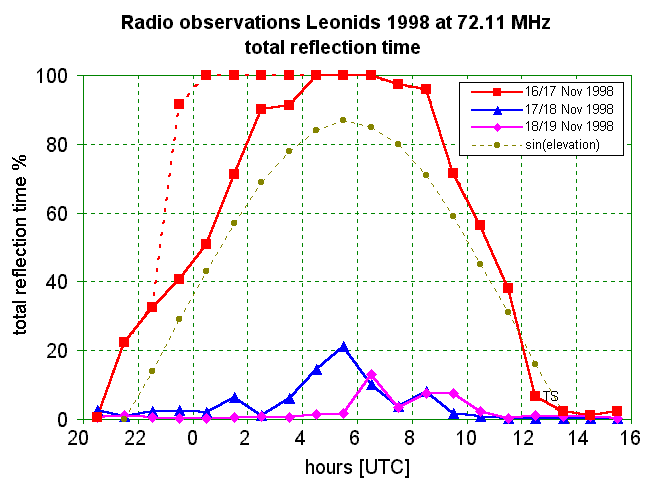
The hourly counts of meteors stronger than 0.1 mV is given in Figure 2. From this figure, and also from recorder charts, it is clear that the number of counts dropped by about 50% between 23h00m and 3h30m UTC. Probably one or more of the transmitters were shut down or power was reduced. A provisional correction has been applied for this effect in Figure 1 (dashed line for 16/17 November). After this correction the activity is more pronounced between 0h and 2h UTC. In Figure 2 also the hourly counts for 7/8 November 1998 are displayed as indication of the normal sporadic activity.
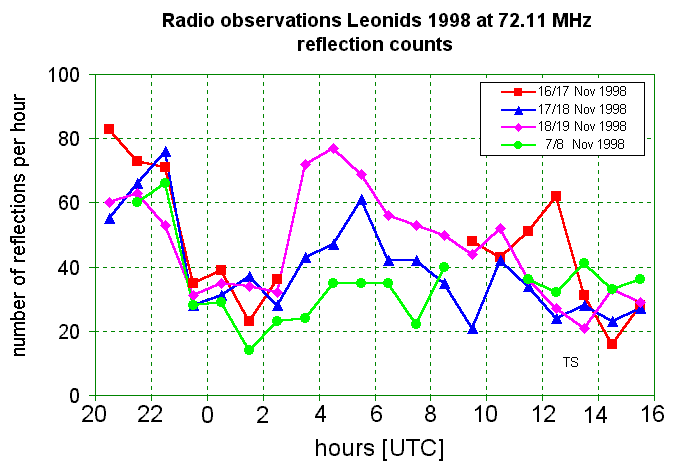
LEONIDS 1998
Everybody could hardly wait for the maximum of the Leonids that should take place in the night
of November 17 to 18 1998. At clear skies there should be a possibility that also in western Europe
this famous meteor shower could be observed. The moon would not disturb this time. Important
astronomers did there best to make clear that everybody should look at the coming heavenly
fireworks. In my particular case the shower should be observed by means of the reflections of
radiowaves, so independent of clouds and disturbing light. As emitter we used radio Wroclaw at
the frequency of 72.11 MHz. Only the height of the radiant above the horizon and much less the
azimuth should determine the possibility to detect a meteor. While it always is wise to begin
observations one or two days before the (expected) maximum the action was started at November 16,
22 UT after the rise of the radiant. The figures allready show at that moment a high activity with
a lot of longer reflections. If this were a sign for the real maximum that should occur during
the next night, it was very promissing. The break from 3 till 9 UT was well used to come in a good
shape for the real work in the night of November 17/18.
During the morning at November 17 the activity, especially of the longer reflections, was still
very high. After the setting of the radiant at about 14 UT no reflections could be received anymore,
and preparations for the coming night began!
Meanwhile a newspaper wrote that observers in Korea had allready observed the maximum at November
16, while the Europeans were still waiting for the radiantrising. Hope did not get lost, but
observations after the rising of the radiant at November 17, about 22 UT, made clear that the
activity was back to the sporadic level and that the Leonids were gone for this year. They came
one night too early!

Figure 1. The total hourly rates per hour of the Leonids (n), corrected for the sporadic background, reflectiontime and breaks, are following the height of the radiant (h,%) very well. It shows a rather flat activity pattern, exept at the beginning of the observations. The activity of the Leonids must have been relatively higher there. At the end of the 17th of November the activity was almost reduced to zero again.
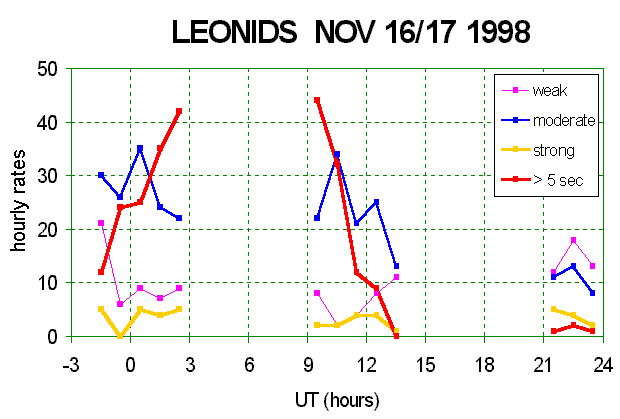
Figure 2. The hourly rates per hour of a number of different kinds of reflections, corrected for reflectiontime and breaks. Clearly seen is the dominant behaviour of the long signals, which practically only belong to the Leonids.
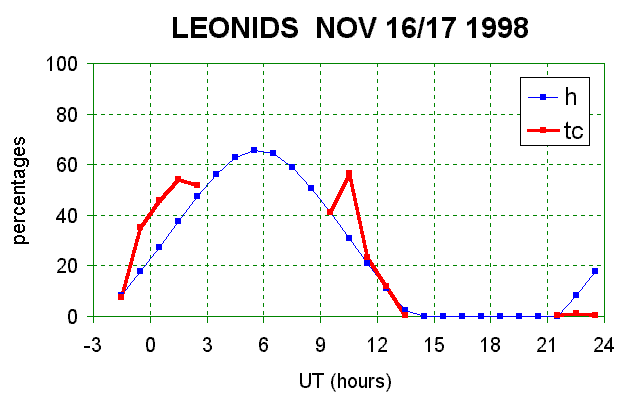
Figure 3. The reflectiontime in percentages of one hour (tc) and corrected for the messured reflectiontime and breaks. This one as well follows the height of the radiant (h,%) and disappears to the end of November 17 practically completely.
NOTE:
GENERAL INFORMATION
Observer : W.T. Zanstra
Location : Appingedam, Netherlands, (6 degr 51' E, 53 degr 19' N).
Frequency : 72,110 MHz
Transmitter: Wroclaw, Polen, (16 degr 43' E, 50 degr 52' N),
distance 735 km, power 135 kW.
Antenna : 5 el. Yagi, elevation 12 degr, azimut 110 degr(ESE).
Receiver : Bearcat UBC 177 XLT scanner, sensitivity 0,8 muV.
Obs. method: listening.
W.T. Zanstra
Spijkerlaan 13
NL-9903 BB Appingedam
Nederland
Tel: 00.31.596.625617
E-mail: wimzanstra@freemail.nl
Observer : Henk Scholtens Location : north-western part of the Netherlands Date : November 17, 02:45 - 06:00 UT Teffective: 03h08m Clouds : very changeble: between 10% and 95% cloudcover Hourly counts Leonids. 02:45 - 03:00 16 03:00 - 04:00 124 04:00 - 05:00 148 05:00 - 06:00 116 ------------------- 02:45 - 06:00 404 Magnitude distribution. Mv -12 -10 -6 -5 -4 -3 -2 -1 0 +1 +2 +3 +4 Flash Total Spo 0 0 0 0 0 0 0 1 0 0 1 0 0 0 2 Leo 1 2 5 10 18 33 89 80 58 36 30 11 7 24 404 ------------------------------------------------------------------- Total 1 2 5 10 18 33 89 81 58 36 31 11 7 24 406

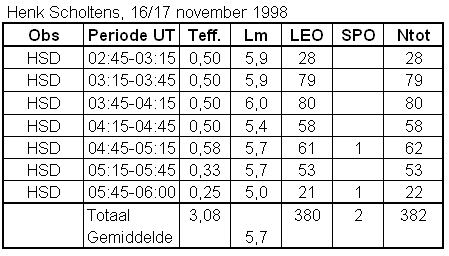

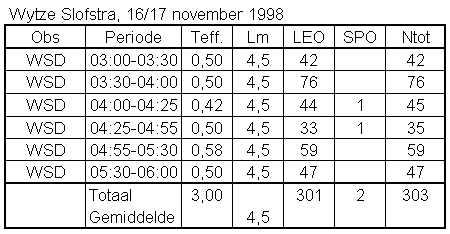



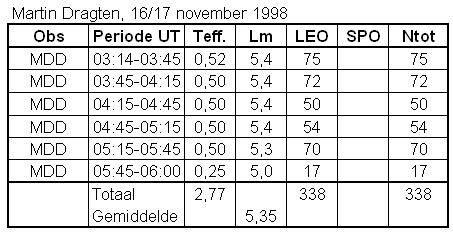

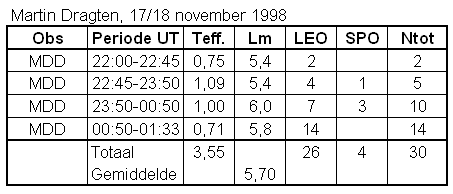
Dear friends,
In the local night from November 16 to 17 I observed the Leonids. Wow,
what a show it was. More Leonids appeared than I bargained for. Let's
start with the beginning: At midnight I went to my usual observing site,
Boca Mahos, at the northern coast of Aruba. When I arrived there it was
cloudy from the northern horizon to the zenith. Because clouds tend to
dissappear very fast on Aruba, I decided to wait. But it stayed the
same, and after it started raining there (water, not meteors) I decided
to try my backup location. So I went to the natural park Arikok, to
observe in a valley at the feet of the hill Yamanota "mountain". This
proved to be a wise decision, because I had hardly any clouds there.
When I was getting ready for observations, I saw already more Leonids
than during last years observations. I started observation at 1h30 local
time. The activity was already very high, although the radiant was low.
I was surprised by the high number of Leonids with negative magnitudes.
Almost all fireballs (and many fainter meteors) showed flares, and
sometimes changed colours when they moved through the sky. Many Leonids
left persistant trains. Some fireballs were so bright, that they cast
shadows behind trees, cacti and rocks. Some fireballs I only noticed
because of the shadows they did cast.
Some very notable fireballs:
6h41m UT: A -5 Northern Taurid fireball, majestically moving through the
sky with a brilliant blue colour.
8h17 UT: A -14(!) Leonid (conservative estimate). I looked straight at
the location where the fireball appeared, so the meteor blinded me! The
persistent train was at first -2, and very colourfull. The beginning of
the trail was yellow, the end showed a blue colour. Due to winds this
trail soon changed to a questionmark form. After three minutes this
train disappeared from sight.
9h03 UT: A -6 Leonid. The beginning of the trail was blue and the end of
the trail was yellow. At the end the fireball flared to -6. It left a
persistent train of 16 (!) minutes. The train formed to a questionmark
form due to the winds in the higher atmosphere.
9h14 UT: A -2 Leonid with two flares: one blue, the other yellow. These
are only the most noteworthy ones, because they showed some special
features. I still blame myself for not bringing a camera and tripod,
because I could have made some very impressive Leonid pictures. Besides
the Leonids, also the minor streams showed some activity, as you can see
below.
Observer : Erwin van Ballegoij
Location : Yamanota
Coordinates: 12 degrees 29' North 69 degrees 57' West
Date : November 17 1998
Time (UT) Teff F Lm LEO NTA STA AMO SPO TOT
5:30-6:30 0.79 1.03 6.20 37 2 2 0 8 49
6:30-7:30 0.82 1.01 6.20 58 1 2 1 8 70
7:30-8:30 0.85 1.00 6.18 62 0 1 1 5 69
8:30-9:30 0.92 1.00 6.10 79 1 0 1 6 87
236 4 5 3 27 275
Magnitude distribution:
<-5 4 3 2 1 0 1 2 3 4 5 TOT mean M LEO 5 9 13 12 20 18 39 53 38 22 7 236 0.94 NTA 1 0 0 0 0 0 0 0 1 1 1 4 1.75 STA 0 0 0 0 0 1 1 0 0 3 0 5 2.60 AMO 0 0 0 0 0 0 0 0 0 1 2 3 4.67 SPO 0 1 0 0 0 0 0 2 5 8 11 27 3.78 In the local night of November 17 to 18 I also observed, but the activity was much lower. The report of this night will follow after I processed the tapes. Yours, Erwin van Ballegoij ************************************************************************
Dear friends,
After observing late last night and working all day, I've tried to start
observations again on 1h30 local time. But apparently I was so tired
that the alarmclock didn't wake me up. Two hours later than intended I
woke up. But it wasn't that much of a problem that I woke up later,
because it was totaly clouded. It even had rained. I decided to give it
a try anyway, so I went to the same location I went to yesterday. When I
arrived the cloudcover was dissolving and a quarter of an hour later I
could start observations, with only 20% of the cloudcover left. A few
minutes later the cloudcover had disappeared completely. Clouds hampered
the observations from time to time, but were a minor inconvenience. One
time I had to quit observations for six minutes because it was almost
completely overcast. But I still saw three Leonids through these clouds,
two of them had a negative magnitude for sure.
This night was the best night I ever had on Aruba. Because of the rain,
there was no dust in the air anymore, and in the beginning the limiting
magnitude was around 6.4. Although the circumstances were good, the
number of visible meteors was much lower. It was clear the Leonid
activity had dropped considerably. Only one -4 Leonid-fireball was
visible (flaring one again, just like all the fireballs yesterday).
Observer : Erwin van Ballegoij
Location : Yamanota, Aruba, Dutch Antilles
Coordinates: 12 degrees 29' North 69 degrees 57' West
Date : November 18 1998
Time (UT) Teff F Lm LEO NTA STA AMO SPO TOT
7:30-8:30 0.74 1.08 6.40 15 1 0 0 5 21
8:30-9:30 0.80 1.06 6.19 19 0 0 0 12 31
34 1 0 0 17 52
Magnitude distribution:
-4 -3 -2 -1 0 1 2 3 4 5 mean M
LEO 1 0 0 0 3 2 10 6 5 6 2.26
NTA 0 0 0 0 0 0 0 1 0 0 3.00
SPO 0 0 0 0 0 0 3 4 6 4 3.65
------------------------------------------------------------
Yours,
Erwin van Ballegoij
--
**********************************************
* Erwin van Ballegoij en Heidi van der Vloet *
* Tarabanaweg 9 *
* Oranjestad, Aruba *
* tel: ++ 297 821918 *
* e-mail: ballegoy@setarnet.aw *
**********************************************
The results of the Leonids of 17/18 nov 1998 from the Public Observatory near Lattrop, Netherlands and somewhere in the fields near Diepenheim, Netherlands.
Date : 17/18 nov 1998
Observer : Rita Verhoef
Code : RVL/RVD
Obs. time : 21h.45-05.00 UT
T. eff : 3.75
Total obs. meteors : 124
Place : Lattrop 52'25/6'58 and Diepenheim 52'14/6'32
Magnitude : 5.4
The first 15 min. I observed in Lattrop, but it became cloudy.
U.T. T. eff LEO TAU SPO
21h45m-22h00m 0.25 3 1
After 2.5 hours I heard that the sky opened more to the west and I
drove to Diepenheim. Somewhere in the fields I saw the other meteors.
U.T. T. eff LEO TAU SPO
01h30m - 02h00m 0.5 12 1 5
02h00m - 02h30m 0.5 17 4 2
02h30m - 03h00m 0.5 14 7
03h00m - 03h30m 0.5 7 2 3
03h30m - 04h00m 0.5 15 3
04h00m - 04h30m 0.5 12 1 5
04h30m - 05h00m 0.5 9 1
Total 89 9 26
Attention please:
This page provides observational results on the Leonids obtained in the Netherlands
Please do not forget to consult the observational results of the
of the Sino-Dutch Leonid Expedition 1998 to China.
Whenever you access this page please be sure to reload it while new information may be added. Happy reading!
Please do not forget to visit the website of Dr. Peter Jenniskens Airborne Mission for first
results of the "Leonid Multi-Instrument Aircraft Campaign".
We also would like to point you to our fellow observers of the
International Meteor Organisation (IMO) who will have obtained observational results too.